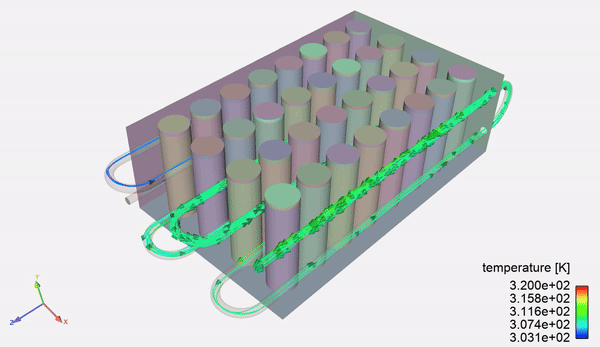Turbulence modelling and Machine Learning
This is a scale resolving simulation of flow past a cylinder at critical Reynolds number (140,000). The physics of the flow is driven by laminar-turbulent transition of the boundary layer which determines the drag force on the object. The vortical structures from the flow field are visualised using Q-criterion. This is helpful in designing crucial components for aerospace applications.
In addition, we plan to use the simulation data to train (physics-informed) neural networks that mimic complex fluid flows.
Forced Convection

Lithium-ion battery pack and heat pipe

Micro heatpipe in electronic components
Thermal management of lithium battery packs using heat pipes presents several significant challenges due to the unique requirements and behaviours of lithium-ion batteries. The focus of the research is on enhancing the overall heat transfer coefficient for internal forced convection when the cooling liquid is embedded with nano-encapsulated phase change materials.
Surface tension plays a crucial role in achieving better heat transfer due to capillary-induced fluid movement through microchannels. Such designs are used for better thermal management of sensitive electronic components.
Phase-Field Lattice Boltzmann Solver for multiphase fluid dynamics
The solvers combines the advantages of phase-field modelling and Lattice Boltzmann Method to effectively simulate complex fluid dynamics and phase transitions involving multiple scales, making it suitable for capturing the complex fluid dynamics and meso-scale transport phenomena in materials science and biological systems.
Reactive flows in porous media
Pore-scale simulations of electrochemical systems couple the multi-physics, multiscale phenomena of fluid flow and transport of charged particles through the electrolyte and the solid phase, along with reactions at the solid-electrolyte interface. These simulations offer valuable insights into optimizing the design and performance of electrochemical devices including batteries, fuel cells and supercapacitors, by helping researchers understand how changes in the microstructure influence macroscopic properties like power density, efficiency, and degradation.
Fragmentation and spray
Fragmentation of liquid sheets involve complex interplay between different interfacial instabilities. The main interest lies in understanding the droplet size distribution in the applications of fuel sprays generated from pressure swirl atomizer. Full 3D simulation using Volume of Fluid (VOF) based tracking is used to capture the hollow cone, sheet breakup, and droplet formation.

Hypersonic flows and shock waves

The hypersonic flow over complex geometry is often accompanied with shock waves and the interaction of shock-shock/boundary-layer often creates complex wave patterns and is subjected under large thermal loads. The measurement of heat flux in such conditions is crucial for the design of hypersonic vehicles as well as challenging. So, development of fast response thermal sensors such as coaxial thermocouple and thin film gauges are crucial which can trace heating history in the range of millisecond and less. Shock-wave based medical instrumentations such as shockwave-driven needle-free drug delivery system, shock-wave therapy for some specific tumor treatment etc., can be use in future for medical treatment.
Aeroacoustics

Acoustic noise control is a crucial demand for aviation, wind turbine, and automobile industries. Our investigation, which delves into the complex and interdisciplinary nature of noise generation due to the flow interactions of different momentum fluids or due to the flow and structural interactions, is a significant undertaking. An anechoic subsonic wind tunnel facility was established inside the Heat transfer lab to perform experimental analysis of aeroacoustics noise generation, furthering our goals.
Turbomachines

The image show the Radial Inflow Turbine (RIT) CFX model and the velocity streamlines through it. In RIT, the fluid enters the stage through an inlet volute, then passes through a nozzle row which accelerates the flow, enters the rotor where output power is produced and finally passes though an exhaust diffuser. Radial inflow turbines find application in turbochargers, waste heat recovery, ocean thermal energy conversion, geothermal power plants, small gas turbines etc.
Interfacial phenomena and gravity waves

In smaller length scales, where surface tension is dominant, interfaces generate shapes countering gravitational pull in static equilibrium. When this balance is disturbed, they undergo complex yet fascinating shape transitions that involve surface tension, inertia, viscosity and sometimes even gravity until another equilibrium state is reached. Our specific focus is on cavity collapse and self-focusing jets, aiming to understand how mass and momentum are transported across the interface. This has particular relevance in applications such as oil spills, 3D printing, and needle-free drug delivery.

In the larger scale limit, we focus on the nonlinear interaction of gravity waves at the liquid surface. Such interactions could create vortical structures at the liquid surface. The nonlinear wave field at the surface could be used to remove floating debris from water bodies and generate energy, which is the focus of our investigation.
Fluid structure interaction & Flow control

Vorticity field for circular cylinder undergoing rotation in a fluid flow

Vorticity field for circular cylinder undergoing oscillations in a fluid flow
The dynamic interaction between fluid forces and structural responses presents critical challenges in flow control, making fluid-structure interaction problems essential to various engineering applications. These include vortex-induced vibration, flutter of aerodynamic components in aircraft, structural stability and noise control in wind turbines, and performance enhancement of marine vehicles and blood flows. Overcoming the challenge of maintaining numerical stability in computation, along with mesh generation and boundary condition fixing at the interface, is crucial. Both simulations utilized a finite volume method, as illustrated in the figures.
